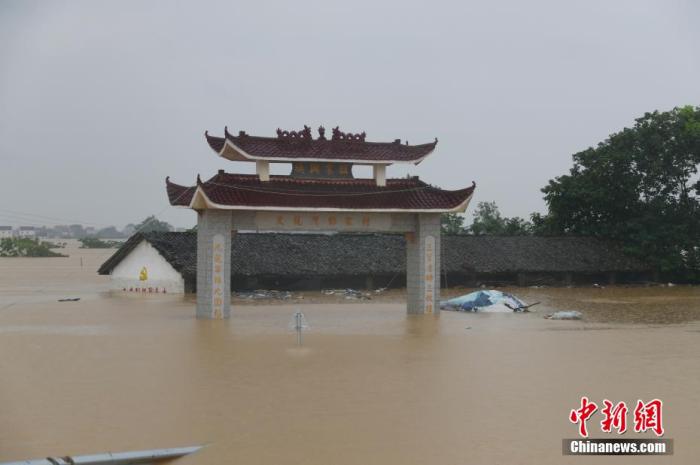China News Service, July 18, according to the official Weibo news of the State Administration of Cultural Heritage, Song Xinchao, deputy director of the State Administration of Cultural Heritage, said in an interview with reporters that according to statistics, as of July 16, Jiangxi, Anhui, Hunan, Sichuan, Guangxi and Hubei , Chongqing, Guangdong, Fujian, Guizhou, Zhejiang and other 11 provinces have more than 500 immovable cultural relics suffered losses to varying degrees due to flooding, including 76 key cultural relics protection units nationwide and 187 provincial cultural relics protection units.
Data map: There is private house immersed in water at the flood site. Photo by Liu Zhankun
Song Xinchao pointed out that this year's flood season has a wide range of damaged cultural relics, a large number, and large losses. It is the most severely damaged cultural relic in recent years. The damage of cultural relics in the provinces of the Yangtze River Basin is relatively serious, including 160 in Jiangxi, 144 in Anhui, 62 in Hunan, 41 in Sichuan, 35 in Guangxi and 31 in Hubei. Among the damaged cultural relics, ancient bridges were washed away, ancient city walls collapsed, and cultural relics and houses collapsed more seriously.
"A total of more than 70 bridges were damaged in 11 provinces, including the national key cultural relics protection unit Anhui Huangshan Tunxi Town Haiqiao, Sichuan Aba Red Army Long March Ruins Daweihui Bridge and Jiangxi Wuyuan Tsinghua Rainbow Bridge, etc. were destroyed; national key cultural relics protection The city wall of Xiangyang, Hubei, collapsed partially; the former residence of Li Zongren, a national key cultural relics protection unit, Guilin, Guangxi, Wulong Palace, Wudang Mountain, Shiyan, Hubei, and the provincial-level cultural relics protection unit, Loudi Zhujia Courtyard, Hunan Province. The flood situation in the provinces continues and the security situation of cultural relics flood control is very serious." Song Xinchao introduced.
In response to the severe security situation of cultural relics during the flood season, what measures has the State Administration of Cultural Heritage taken? Song Xinchao said that the State Administration of Cultural Heritage attaches great importance to the work of flood control and disaster relief of cultural relics, and always adheres to prevention, and incorporates the emergency reinforcement and construction of protective facilities of cultural relics units into the key projects of cultural relics protection projects, and incorporates natural disaster response and disposal into emergencies of the National Cultural Relics Bureau. It is an important part of emergency management and provides key support to the repair and restoration of cultural relics after the disaster every year.
Especially since entering the flood season this year, the State Administration of Cultural Heritage has paid close attention to the flood situation in various places, promptly activated the emergency mechanism, issued a telephone warning to the relevant provinces, and immediately issued an emergency notice on strengthening the safety of cultural relics in the flood season, and made specific arrangements for the national anti-flood safety work. All localities are required to maintain a high degree of early warning, pay close attention to flood conditions, comprehensively investigate possible hazards, rectify potential safety hazards, organize disaster prevention and mitigation work properly, properly do the follow-up protection of damaged cultural relics, collect and preserve cultural relics components or parts, Organize the repair and restoration of cultural relics to minimize the loss of cultural relics. Distribute 3.5 million yuan in emergency rescue funds for cultural relics to Sichuan, Hubei, Guangxi, Anhui, Jiangxi, Hunan, Chongqing and other provinces with severe cultural relics disasters.
In accordance with the requirements of the State Administration of Cultural Heritage, the cultural relics departments of various regions have set up emergency organizations for flood prevention and emergency rescue, started the emergency response mechanism for cultural relics during the flood season, and fully organized the work of disaster prevention and mitigation and the aftermath protection of damaged cultural relics. The State Administration of Cultural Heritage will pay close attention to and supervise the flood control and safety work of cultural relics in various places, and will provide key guidance and support on the cost and technology of the restoration and repair of cultural relics after disasters according to the actual damage to cultural relics in various places.
Regarding the major and difficult problems in the work of cultural relics disaster prevention and mitigation, Song Xinchao said that from the current research situation, the research on disaster prevention and mitigation technology is insufficient. The protection of cultural relics and buildings in China’s cultural relics and architectural circles focuses on the architectural pattern, form, and structure. It has not paid enough attention to the role of cultural relics in disaster prevention and disaster prevention, and failed to form a systematic cultural relics disaster prevention concept and technical system. Cultural relics repair China's disaster prevention and mitigation measures lack targeted guidance, and many cultural relics' own disaster prevention and disaster resistance functions have not yet been fully exerted.
In addition, Song Xinchao introduced the arrangements and considerations of the State Administration of Cultural Heritage in the prevention and mitigation of cultural relics, mainly mentioning five measures, including integrating into the disaster prevention and mitigation system, strengthening research on disaster prevention and mitigation, and considering disaster prevention issues in the restoration of cultural relics. Improve the cultural relics disaster prevention and mitigation emergency plan, and play the cultural relics' own disaster prevention function.

